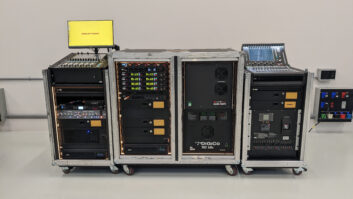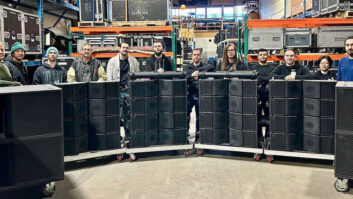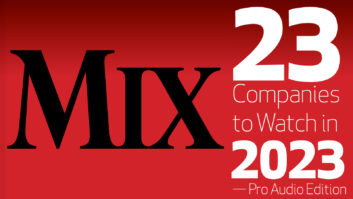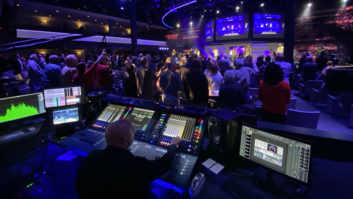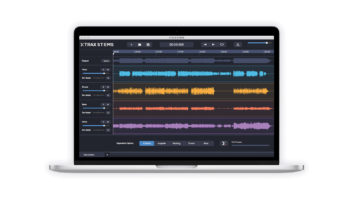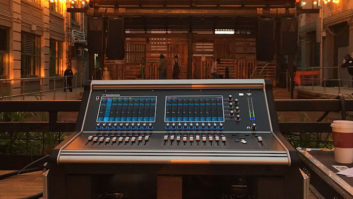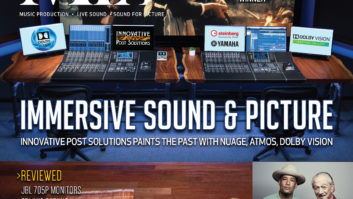Today’s touring and special-event productions are more complex and technically demanding than ever before. In recent years, live sound system designers and operators have increasingly had to make provisions for in-ear monitors, multilevel and “B” stages, frequent set and costume changes, and the incorporation of prerecorded material. Touring console manufacturers have responded to the market demand and now offer dozens of increasingly sophisticated and flexible control systems for FOH and monitor mix applications.
But the current touring season has introduced a new problem: plummeting box office receipts and a looming recession. Today’s live sound system operators are under increasing pressure from their clients to “slim down” and produce tighter truck packs, shorter load-in times and smaller FOH compounds. In this less-than-rosy business environment, the traditional customers for large-format mixing consoles for live sound must think very carefully before committing to their next purchases.
Fortunately, the selection of large-format mixing consoles (40 inputs and up) suitable for FOH and monitor applications has never been greater. Analog consoles provide stable technology, ever-improving noise and distortion specs, and competitive prices. Digitally controlled analog consoles combine sample-accurate repeatability with a dazzling menu of functionality that is often only restricted by system memory. Despite some initial skepticism, fully digital consoles are now firmly established as reliable and effective alternatives, and, despite their comparatively high purchase costs, they offer significant economies for multi-act productions and situations where space is limited.
Mix surveyed the current crop of large-format consoles, looking at the “top of-the-line” model from each manufacturer. (See the sidebar on page 158 for manufacturers’ contact information.) Also, visitors to this month’s AES Convention in New York will no doubt see the introduction of at least one new large-format console. If you can’t make it to the show, then look for our post-AES coverage in the November issue of Mix.
The analog ML5000 from Allen & Heath is a dual-function FOH/monitor console incorporating the company’s LCRplus™ panning system and robust VCA assignment, mute and snapshot automation features. Audio routing is via 24 group and auxiliary buses, eight VCA groups and an extensive output matrix. Input and output mutes can be assigned to one or more of eight dedicated mute groups, and the ML5000’s console mute and VCA assignments can be stored in 128 snapshot memory locations. Up to two 24-channel sidecar expanders can be added, allowing for more than 100 mono and stereo input channels. EQ is 4-band with fully parametric mids. Additional features include 20 analog VU meters, Windows-based snapshot-memory archiving software and an intelligent PFL/AFL system. Price is $29,999 for a 56-input configuration (48 mono inputs, 4 stereo).
Complementing the company’s Paragon II Monitor Console, the Paragon II Production Console from Audio Toys Inc. (ATI) is designed as an analog FOH mixer for live sound, broadcast production and live theater applications. Offering 64 microphone inputs (expandable to 100), 12 stereo input pairs and a dizzying array of outputs (including eight mono and four stereo aux buses and eight stereo groups), the Paragon II features a fully equipped dynamics processing package on each input channel. ATI’s new Distributed Intelligence™ onboard computer design stores and maintains all channel, group and master scene information within a flash micro-controller on every input channel, an architecture that enables the system to respond instantaneously, eliminating system boot-up and response wait times. Prices start at $119,000.
The R-Type Live Production Console from Cadac features a new lightweight, monocoque-engineered, 24-slot frame and is designed for a “two-man lift.” A cost-efficient analog touring mixer that can install quickly, the R-Type provides FOH and monitor mixing facilities, and incorporates Cadac’s interchangeable console modules that can be located in any slot and in any frame. Including the dedicated output section, DC master, and LCR and stereo output modules, the R-Type can be loaded with a total of 51 mono and stereo inputs. Custom R-Type console configurations can handle 200 inputs and beyond. Price for a “fully loaded” R-Type approaches $190,000.
The dual in-line S/L56 56-input analog console from Carvin offers a high feature-per-dollar ratio. Live mixers benefit from each channel’s eight aux sends (two effects/four independent monitor sends and stereo in-ear monitoring) and Analog Devices mic/line preamps, as well as the S/L line’s ergonomically redesigned rotary knob and fader spacing for increased dexterity in a critical live mix. Two mid-sweep EQ knobs per channel control the 80 to 5k Hz frequency range, a switchable low-cut filter frees up wasted power in the bottom end, and a rackmount 400-watt power supply (more than double the S/L56’s requirement) is standard. Price is $4,999.99.
Crest Audio spent five years on its analog console development program, and the flagship V12 is the result. Designed for both live concert and theatrical applications, the V12 offers the ability to create eight mono, five stereo and up to 28 additional output mixes. Features include 12 VCA groups for level and mute control and true LCR panning. EQ on input modules is fully parametric 4-band with 18dB/octave highpass filters. MIDI-based automation features are under microprocessor control, with a front end provided by JL Cooper or Crest’s own NexSys Computer Control System. An optional link system can accommodate up to three main consoles and two 30-input sidecar expanders to create a single 212 mono/stereo-input console. Price for a 52-input channel version is $72,000.
The DCX Event 40 from Gamble Associates is a digitally controlled analog console packaged in a 56-inches-high by 45-inches-wide, self-contained, double-bay rack. The virtual console allows control of all functions via dual display screens and an optical mouse; using the Zoom View function is like looking at a portion of a typical console surface through a piece of glass. Offering 40 channels to control 80 mic and 80 line inputs, the DCX Event 40 is configured for eight stereo subgroups with inserts, 16 stereo aux sends and eight stereo matrix sends. As one would expect from a Gamble product, noise and distortion specs are exemplary; the DCX 40 has no phase shift within the audible range of 5 to 20k Hz. All electronics sit on 60 plug-in module cards housed in VME-type cardcages with separate power supplies for each. In space-critical situations, the DCX Workstation Roadcase may be placed at the FOH mix location with the DCX Event 40 Rack located onstage; a supplied 100-meter CAT-5 wire links the two units. Price is $250,000.
The Live Performance Console (LPC) from Harrison/GLW is a digitally controlled analog system that was jointly developed by Harrison and Showco. With a control surface measuring just 74×40 inches, the LPC uses BeOS-based control software to control all audio parameters for as many as 720 mic and 240 line inputs arranged in three 80-input audio processing racks. (Each input features one line and three mic inputs.) The audio processing racks, normally situated on or near the stage, contain all audio cards and I/O interfaces. An automation computer in the processing rack executes all changes to routing and signal processing, as instructed by the digital control surface via a fiber-optic link. Because no audio passes through the control surface, any interruption of the digital data stream passing between the control surface and the processing racks is effectively inaudible — all audio assignments, levels and EQs remain frozen until the system resets and the control surface picks up where it left off. Because of its comprehensive routing and instant recall capabilities, the LPC may be used for either FOH or stage monitor mixing. Each channel features a full dynamics section, 4-band EQ, high- and lowpass filters, and 32 sends. Price is $250,000.
As with other Innova-Son consoles, the new Sensory Large Scale Series digital console consists of a control panel (the same as for the Sensory Live Series) that connects to dedicated stage boxes via lightweight, coaxial cables. The all-digital system supports up to 96 input channels, each of which features a digital input gain trim, 5- or 8-band parametric EQ, and comprehensive dynamics control. Notch filters and delay processing functions are also available, with instant recall of all settings and comprehensive PFL and AFL monitoring throughout the signal path. The output section includes an LCR master, 46 pre-mix bus and 20 matrix bus outputs, each equipped with 8-band parametric EQ, dynamics and delay functions, and individual level control. The Large Scale is also the first Innova-Son system to use the ergonomic Hierarchies Pre-Mix Architecture™ organizational software. The Large Scale console, which can be configured to handle up to 164 inputs and 144 outputs, starts at $140,000.
Level Control Systems (LCS) recently introduced its CueConsole, a proprietary control interface that works in tandem with the company’s existing LCS system to provide a flexible all-digital FOH or monitor mixing platform that may be configured to match almost any requirements. One or more CueConsole systems may be linked to the LCS SuperNova™ or Matrix3™ audio engines via four types of control modules (Transporter, Fader, Meters+ and Editor). Multiple Matrix3 audio control system frames can be linked to provide a staggering 400-input/512-output system, all controllable from one CueConsole surface. (Multiple control surfaces may also be distributed for local submix control.) Because of the modular design and the capability to selectively reassign fader control to multiple inputs and outputs, the CueConsole offers an extremely cost-effective solution when FOH mixing space is restricted or expensive, a common problem for theatrical productions. CueConsole systems start at $80,000.
The SR56•8 from Mackie Designs is the company’s latest large-format analog sound reinforcement console. Laid out in a 56×8×3 configuration with eight subgroups, center master section, LCR main outputs, four extra stereo aux return strips and a 12×4 matrix mixer, the SR56•8 features Mackie’s VLZ input channel circuitry for reduced noise and channel crosstalk. Channel EQ is 4-band with high and low sweepable mids, and “Air” HF circuitry. Additional features include Mackie’s UltraMute™ computerized group muting system, a flip switch for exchanging stage monitor application functions and a new “monorail” tapered fader design. Price is $13,595.
Midas now offers the XL4 Touring Package, which includes a flight case and extra power supply. The analog XL4’s 48 mic inputs now feature an improved mic preamp design, and treble and bass sections of the EQ section now offer an extended frequency range and are switchable to fully parametric operation. Sixteen main audio groups can be assigned to any of eight automute groups and VCA control via 12 motorized VCA master faders. Up to 2,000 snapshot mix scenes can be recalled instantly, and all of the XL4’s dynamic and snapshot automation features can be imported/exported in a variety of formats, either for archiving or for multiple console and system linking applications. The XL4 Touring Package is priced at $176,675.
The analog Series FIVE from Soundcraft USA is designed for a wide range of live touring and theater applications. Various frame sizes can accommodate from 24- to 56-channel configurations; LCR panning, 100-millimeter faders and a built-in 16×10 output matrix are standard. Each input channel offers four stereo mic/line inputs with fully parametric 4-band EQ and sweepable filters on both mono and stereo inputs. The Series FIVE is also MIDI-controllable. Price is $61,495 for the 52-input version.
The Yamaha PM1D is a fully digital large-format console for touring or installed sound. Features include complete recall and undo and a 32-bit internal audio path, and the system is capable of controlling up to 384 inputs, 192 channels and 96 mix buses when fully expanded. The PM1D’s 260-pound, 75×38-inch control surface uses a 68-pin cable and two Ethernet connectors to communicate with the companion DSP-1D digital audio engine, which may be located onstage. If the control surface loses power or is accidentally disconnected from the audio engine, then the system will continue to stream audio without interruption. PM1D configurations include both 48- and 96-channel versions, each furnished with 48 mix buses, 24 output matrices and 12 DCAs. Additional features include 4-band fully parametric EQ and full dynamics processing on inputs and buses, scene memory recall of channel A/B assignments, virtual channels and a user-definable number of aux sends, effects processors and graphic EQs. Prices range from $110,000 to $145,000.
Randy Alberts is a musician, engineer and writer exploring music and recording technology in his Pacifica, Calif.-based studio.
TOURING CONSOLE MANUFACTURERS CONTACT INFORMATION
